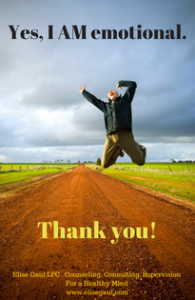“We shouldn’t let emotion sway us,” or “You are too emotional!”
I hear these and their variations in many settings both personal and professional. The first is a directive to others to avoid feelings in favor of a singularly logical solution which is perceived as better.
The second is often proffered as a criticism. Sometimes it is said in a tone of anger or even disgust. If you have ever been admonished in this way, you may know the sting of judgment and the shame such words can elicit.
How did we get to this place where we dismiss or degrade such important messengers? I say “messengers” because we feel emotions as a result of chemical messengers in the brain AND because emotions provide vital information. Here are some simple messages and their emotions for example:
I love this! = Happy
I don’t want this! = Anger
This is dangerous! = Fear
Something terrible happened. = Sadness
We can’t forego these certainly. These messages help us make good choices. When we pick up these signals from another person, we get information about whether to move closer or move away. These signals can actually keep us safe. In other situations, seeing the tears of another can impel us to feel that emotion empathically and we move in to help. This is successful socialization in action.
Emotion is difficult to define because it really is a process. It is a reaction to sensory information (a very broad spectrum) and internal processes like memory. Neuroscience identifies the limbic system as the seat of emotions—this includes the amygdala, hippocampus, and thalamus. The limbic system takes up a significant amount of space in the central brain. In humans there is a great deal of activity between the limbic system and the prefrontal cortex (PFR). The PFR is known for executive functioning and has many jobs including mediating emotions and calming fear.
In session, I often hear my clients say the internalized version of the admonition: “I shouldn’t be upset.” “But,” I say, “you are upset. Let’s figure this out.” Are these emotions providing good information? If we aren’t curious and just try to shut them down—how can we learn anything about ourselves and this process?
Can emotion be too much? Yes, of course, particularly if it is a negative emotion that is hanging on too long or turning into a dark mood we can’t shake. Emotions running rampant over all reason (hijacking the PFR, you could say) can cause big problems. But emotions on their own pose no danger if we can ride them out, understand them, and derive the good information they offer.
Emotions also offer the opportunity for us to learn and practice mediating them effectively and to know from the inside out what we can handle and what is actually “too emotional” for us. No one else can tell us that.
If we avoid emotions:
- We don’t get to practice meditating and integrating them effectively.
- We don’t find out what we can handle in the present and for future reference to move forward with confidence.
- We limit access to vital information about ourselves and others.
Finally, by avoiding or degrading emotions, we give up the vitality they provide to energize a healthy mind and happy life.
So the next time someone tells you you are too emotional, tell them “Thanks! I got this.”

